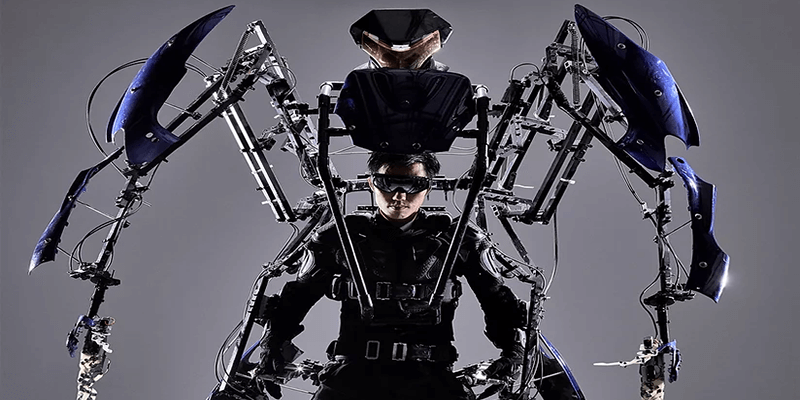Exoskeleton Technology: Unleashing the Power of Enhanced Human Capabilities
Introduction
The Rise of Exoskeletons
In the realm of futuristic technologies, exoskeletons have emerged as a beacon of innovation, offering a glimpse into a world where human abilities are augmented by robotic enhancements. Often reminiscent of science fiction, exoskeletons are, in fact, a tangible reality with profound implications across various industries. This exploration delves into the intricate landscape of exoskeleton technology, unraveling its evolution, diverse applications, challenges, and the transformative impact it holds in shaping the future of human-machine collaboration.
I. The Genesis of Exoskeletons: From Science Fiction to Reality
1. Early Inspirations from Science Fiction:
- Literary Roots: The concept of powered exoskeletons traces back to science fiction literature, with notable mentions in works like Robert A. Heinlein’s “Starship Troopers.”
- Cinematic Influences: Iconic portrayals in movies such as “Aliens” and “Iron Man” fueled public imagination and interest in exoskeletons.
2. Military Origins:
- Early Military Exoskeletons: The development of exoskeletons for military applications, driven by the desire to enhance soldiers’ strength and endurance.
- Powered Armor Concepts: Exploration of powered armor concepts in defense research laboratories.
3. Advancements in Bionics and Robotics:
- Integration of Bionics: The amalgamation of bionic principles and robotic technologies in exoskeleton design.
- Human-Machine Interfaces: Developments in interfaces that allow seamless communication between the exoskeleton and the wearer’s movements.
II. Types of Exoskeletons: A Diverse Landscape
1. Powered Exoskeletons:
- Hydraulic and Pneumatic Systems: Exoskeletons powered by hydraulic or pneumatic actuators for enhanced strength and agility.
- Electric Motors: The use of electric motors for smoother movements and increased energy efficiency.
2. Passive Exoskeletons:
- Mechanical Support: Providing mechanical support to reduce the strain on the wearer without active power assistance.
- Elastic Elements: Integration of elastic materials to store and release energy during movement.
3. Full-Body and Partial Exoskeletons:
- Full-Body Exoskeletons: Covering the entire body to augment both upper and lower limbs.
- Partial Exoskeletons: Focusing on specific areas, such as the lower limbs or upper body, based on application requirements.
4. Medical and Rehabilitation Exoskeletons:
- Assistive Devices: Exoskeletons designed to assist individuals with mobility impairments in daily activities.
- Rehabilitative Applications: Supporting rehabilitation by providing targeted assistance during physical therapy.
III. Applications Across Industries: Augmenting Human Potential
1. Military and Defense:
- Enhanced Soldier Performance: Improving soldiers’ strength, endurance, and carrying capacity on the battlefield.
- Logistics and Load Assistance: Exoskeletons for logistical tasks, such as lifting and carrying heavy loads.
2. Healthcare and Rehabilitation:
- Mobility Assistance: Exoskeletons aiding individuals with mobility impairments due to spinal cord injuries or neurological disorders.
- Rehabilitative Support: Assisting in rehabilitation exercises for patients recovering from strokes or surgeries.
3. Industrial and Manufacturing:
- Ergonomic Support: Exoskeletons designed to reduce physical strain on workers in industries with repetitive tasks.
- Precision and Control: Enhancing precision in manufacturing processes by providing steadier movements.
4. Construction and Heavy Industry:
- Lifting and Handling: Exoskeletons supporting workers in lifting and handling heavy construction materials.
- Reducing Fatigue: Alleviating physical fatigue during prolonged periods of labor-intensive tasks.
5. Aerospace and Astronautics:
- Astronaut Mobility: Exoskeletons designed for astronauts to navigate in microgravity environments.
- Reducing Muscle Atrophy: Mitigating the effects of muscle atrophy during extended space missions.
IV. Technological Advancements in Exoskeletons: Precision and Adaptability
1. Sensing Technologies:
- Pressure and Force Sensors: Integration of sensors to detect pressure and forces, enabling real-time adjustments in exoskeleton movements.
- Biomechanical Sensors: Sensors that monitor the wearer’s biomechanics for precise and natural motion replication.
2. Artificial Intelligence Integration:
- Machine Learning Algorithms: Employing AI to adapt the exoskeleton’s behavior based on the user’s movements and preferences.
- Predictive Analytics: Anticipating user actions to provide proactive support and enhance overall efficiency.
3. Compact and Lightweight Designs:
- Material Advancements: Utilizing lightweight and durable materials in exoskeleton construction.
- Miniaturization of Components: Shrinking electronic components to enhance portability and ease of use.
4. Energy Efficiency and Battery Technology:
- Longer Battery Life: Advancements in battery technology for extended usage without frequent recharging.
- Energy Recapture Systems: Mechanisms to capture and recycle energy generated during movement for improved efficiency.
V. Challenges and Considerations: Navigating the Exoskeleton Frontier
1. Cost and Affordability:
- High Initial Costs: The financial barrier to widespread adoption due to the substantial costs associated with developing and acquiring exoskeletons.
- Economic Viability: Balancing the benefits of exoskeletons against their economic feasibility, especially in industries with budget constraints.
2. User Interface and Ergonomics:
- Intuitive Controls: The need for user-friendly interfaces that allow wearers to control and adapt the exoskeleton effortlessly.
- Comfort and Fit: Ensuring ergonomic designs that prioritize wearer comfort during prolonged use.
3. Regulatory and Safety Concerns:
- Safety Standards: Establishing industry-wide safety standards for exoskeletons to ensure user well-being.
- Regulatory Approval: Navigating regulatory processes to ensure compliance with safety and performance standards.
4. Social and Ethical Implications:
- Job Displacement Concerns: Addressing concerns related to the potential displacement of jobs as automation through exoskeletons increases.
- Equitable Access: Ensuring that the benefits of exoskeleton technology are accessible to a broad spectrum of users without exacerbating social inequalities.
VI. Future Horizons: A Paradigm Shift in Human-Machine Collaboration
1. Enhanced Personal Mobility:
- Everyday Use: Envisioning exoskeletons as everyday tools, assisting with tasks ranging from commuting to household chores.
- Accessibility: Designing exoskeletons with accessibility in mind, catering to diverse user needs and abilities.
2. Cognitive Augmentation:
- Brain-Machine Interfaces: Integrating exoskeletons with brain-machine interfaces for seamless control based on neural signals.
- Enhanced Cognitive Abilities: Exploring possibilities for cognitive augmentation through exoskeleton technology.
3. Collaborative Robotics:
- Human-Robot Collaboration: Creating synergies between humans and robots in workplaces, enhancing productivity and safety.
- Interconnected Systems: Developing ecosystems where multiple exoskeletons can communicate and collaborate, fostering collective efficiency.
4. Personalized Healthcare Solutions:
- Tailored Rehabilitation: Customizing exoskeletons for individual rehabilitation needs, offering precise support for different medical conditions.
- Aging Population Support: Providing assistance for elderly individuals to maintain mobility and independence.
VII. Ethical Considerations and Social Impact: Shaping an Inclusive Future
1. Ethical Deployment:
- Transparency: Ensuring transparency in the development and deployment of exoskeletons to build trust among users.
- Ethical Use of Data: Addressing concerns related to the collection and utilization of user data by exoskeleton systems.
2. Societal Acceptance:
- Public Perception: Nurturing a positive perception of exoskeletons to foster acceptance and integration into society.
- Education and Awareness: Raising awareness about the benefits and limitations of exoskeleton technology to mitigate fear or skepticism.
3. Accessibility and Equity:
- Universal Design: Prioritizing universal design principles to create exoskeletons that cater to diverse needs.
- Affordable Access: Striving for affordability to ensure that exoskeleton benefits are not limited to specific socioeconomic groups.
Conclusion: Forging a Future of Empowered Humanity
In the symphony of technological advancements, exoskeletons emerge as a transformative crescendo, echoing the potential to redefine human capabilities and charting a course towards a future where augmented strength, endurance, and mobility are not just possibilities but realities. As we conclude this exploration into the realm of exoskeleton technology, it is evident that we stand at the precipice of a new era—one where the synergy between man and machine reaches unprecedented heights.
The journey from the realms of science fiction to the tangible deployment of exoskeletons in diverse industries reflects not only the trajectory of technological progress but also the human capacity to turn imagination into reality. Initially conceived for military applications, these robotic exoskeletal companions have gracefully stepped into the realms of healthcare, industry, and personal augmentation, signaling a paradigm shift in our understanding of human-machine collaboration.
The diverse landscape of exoskeletons, ranging from powered and passive designs to those tailored for specific industries and medical rehabilitation, mirrors the breadth of possibilities that this technology offers. The fusion of sensing technologies, artificial intelligence, and ergonomic designs underscores a commitment to precision, adaptability, and user comfort, positioning exoskeletons as more than mere tools but as extensions of the human potential.
As we look to the future, the horizons painted by exoskeleton technology go beyond the realm of physical augmentation. The prospect of everyday use, cognitive augmentation, collaborative robotics, and personalized healthcare solutions paints a tapestry where these robotic exoskeletons seamlessly integrate into the fabric of our daily lives. Whether it’s supporting an aging population, aiding in rehabilitation, or fostering collaboration between humans and robots, exoskeletons offer a kaleidoscope of possibilities for a more inclusive and capable society.
Yet, the journey is not without its challenges and ethical considerations. From cost barriers to societal acceptance, and from data privacy to equitable access, the responsible deployment of exoskeleton technology requires a delicate balance between innovation and ethical stewardship. The way forward demands collaboration among researchers, developers, policymakers, and society at large to ensure that the benefits are widespread and that the ethical dimensions of this technology are given due consideration.
In conclusion, exoskeleton technology is not merely about donning a suit of robotic armor; it’s about forging a future where humanity is empowered, where physical limitations are transcended, and where collaboration with technology leads to a richer, more inclusive existence. As we step forward into this era of augmented humanity, the narrative of exoskeletons becomes a testament to our capacity for innovation, our resilience in the face of challenges, and our collective endeavor to create a future where the extraordinary becomes the new normal. In the dance between the biological and the technological, exoskeletons beckon us to envision a world where our shared potential knows no bounds—a world where, hand in hand with our robotic counterparts, we embark on a journey toward a future of enhanced capabilities and boundless possibilities.
Related Posts

Cryptocurrency Wallets: Safeguarding the Keys to Digital Wealth

Artificial Intelligence(AI) in Web3: A Paradigm Shift in Intelligent Connectivity







